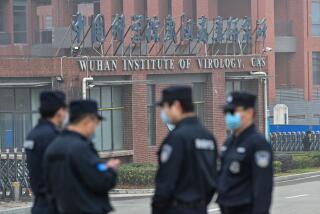Expertise Cited in Use of Bacteria as a Weapon
- Share via
WASHINGTON — With growing alarm but limited facts, lawmakers and scientists Wednesday said that whoever mailed anthrax to a congressional office had overcome significant technical hurdles in turning the bacteria into a weapon, something that even experienced microbiologists could not accomplish.
The fact that 31 congressional staff members and security officers were exposed to the anthrax, which is believed to have arrived in a single letter to Senate Majority Leader Tom Daschle (D-S.D.), suggested to many experts that the bacteria were created by people who understood at least the basics of how to design a biological weapon that could harm a large number of people.
But the dimensions of the threat remained unclear. Even as the notion receded that an amateur had produced the anthrax bacteria, no one could say whether the people who made it had the expertise, the will or materials lethal enough to launch a broader attack that might cause greater harm.
House Speaker J. Dennis Hastert (R-Ill.) said the Daschle letter contained a “sophisticated” form of the bacteria. House Minority Leader Richard A. Gephardt (D-Mo.) said people who have examined it believe it is “weapon-grade,” though others disagreed. A federal bioterrorism expert at a law enforcement agency called it “professionally” manufactured.
“In my view, we’ve now gone from a bunch of amateurs causing pain and suffering and fear to professionals with the ability to kill people, which is not where I thought we were going to end up when this started,” said microbiologist Barry Bloom, dean of the Harvard University School of Public Health.
Army scientists at Ft. Detrick, Md., conducted tests Wednesday that might give clues to the origin of the bacteria and the level of know-how of whoever turned it into the powder that was sent to Daschle’s office. The greatest fear, some scientists and officials said, is that the anthrax would trace back to one of the 13 or so nations suspected of developing biological weapons, suggesting a lack of security in a foreign weapon program, if not state complicity in the attack.
Iraq is known to have produced a weaponized form of anthrax, and the former Soviet Union produced huge quantities, in violation of an international treaty it had signed. Egypt, North Korea and Libya are also suspected of experimenting with it. Now that President Bush has declared a broad war on terrorism, complicity by any of those nations in the attack might prompt U.S. officials to recalibrate their campaign.
Bacterium Is Not Difficult to Grow
Anthrax now has turned up in three states and on Capitol Hill. While traces of the bacteria have been found in at least three dozen people, only four have actually developed the disease. They include two employees of a Florida supermarket tabloid publisher, one of whom has died, and a child and adult at separate television network offices in New York.
The disease is caused by a naturally occurring bacterium found around the world. It is not difficult to grow, and some experts say it is not difficult to turn it into a crude weapon.
But making a refined weapon from the bacteria, one that could find its way to a number of people in the same building, requires significant expertise, scientists and lawmakers said. It also presumes that someone has access to a virulent strain of anthrax, one that can actually harm people.
Scientists and weapon experts said a novice might be able to grow anthrax germs in a broth or culture dish. But the bacteria would be fragile if released, subject to damage even by sunlight. To make them hardy, a person would have to starve them or otherwise shock them, which prompts the bacteria to form spores that can last for decades.
The hard part, experts say, is turning this slurry of bacteria into a fine and concentrated powder. If the clumps were too large, they would fall to the ground and harm no one. If they were too fine, some specialists said, a person would inhale them and then exhale them before they could lodge in the mucus membranes of the lungs.
But particles that are fine yet not too small will hang in the air in a dangerous cloud.
A similar problem faces industrial technicians who make powdered milk or other powders, said Eric Croddy, a weapons specialist at California’s Monterey Institute of International Studies. In past decades, he said, ball bearings were used to crush spores, a process that also killed many of them. Weapon scientists in the former U.S. and Soviet offensive biological weapon programs worked for years to solve that problem.
“A layman could not do all this,” Croddy said.
“Even scientists who work on anthrax don’t know how to weaponize anthrax,” said Karl E. Klose, a microbiologist at the University of Texas Health Science Center in San Antonio, who is working to develop a new anthrax vaccine. “This is classified information that is not spread around.”
David Fleming, deputy director of the Centers for Disease Control and Prevention, said U.S. Army scientists were studying the characteristics of the bacteria found in Daschle’s office, including its particle size, but that results were not yet available.
Maj. Gen. John Parker, speaking for the Ft. Detrick technicians who studied the bacteria, also said he could not comment on particle size. But he did reveal other characteristics about the bacteria.
At a news conference outside the Capitol, Parker said scientists had determined that a wide variety of antibiotics could be used to treat the anthrax, meaning that it had not been manipulated or genetically modified to be an untreatable strain.
Many lawmakers said this meant the bacteria found so far does not present a broad public health threat, because the government has ample antibiotics on hand. Some scientists said this also suggested that a foreign weapon program was not the source of the bacteria. The former Soviet weapon program was believed to be developing a strain of anthrax germs resistant to antibiotics, and other nations pursuing biological weapons would presumably want such as strain, as well.
Parker also said the bacteria in Daschle’s office was “pure spores,” but he did not explain the comment. Lisa Swenarksi, a CDC spokeswoman, said the reference meant that the sample had not been “contaminated with other bacteria or other substances,” and that it had “been cleaned up,” suggesting a degree of sophistication by whoever created it.
Health and Human Services Secretary Tommy G. Thompson and other public health officials also said that anthrax is not contagious, a message they have repeated daily in recent weeks as public concern about the disease has grown.
Ex-Soviet Stores Are Source of Concern
With details about the bacteria sketchy, some officials and scientists speculated that a foreign weapon program had been involved in some way, though not necessarily intentionally.
Rogue scientists within a program could have handed materials to terrorists, they speculated. And facilities in the former Soviet program are known to still hold lethal agents under lax security measures. Moreover, U.S. officials have suspected that Iran, and even Osama bin Laden, have sought assistance from low-paid former Soviet scientists.
The anthrax investigation “is a scientific and technical inquiry, but there is a chance it could become political,” said Richard Butler, who led the United Nations effort to identify and dismantle Iraq’s biological weapon capabilities after the Persian Gulf War. “Iraq, for instance. Russia made an enormous amount, and there are groups in Chechnya and elsewhere who are sympathetic” to Bin Laden.
*
Times staff writers Marlene Cimons, Eric Lichtblau, Rosie Mestel, Josh Meyer and Jonathan Peterson contributed to this report.
More to Read
Sign up for Essential California
The most important California stories and recommendations in your inbox every morning.
You may occasionally receive promotional content from the Los Angeles Times.













